
If you’ve ever wondered how large the front grille of a car could get, you’re looking at it. It certainly doesn’t appear as if the new 2019 Avalon’s grille could get any larger, as it nearly covers the entire front fascia, but no doubt some will like this a lot more than the already gaping maw offered with the outgoing model.
The grille looks bigger in my tester’s entry-level XSE trim due to a glossy black surround in place of top-tier Limited trim’s chrome, while gloss-black mesh grille inserts appear darker and therefore more aggressive than the pricier trim’s matte-black horizontal strips. Following the XSE’s sporty theme rearward, Toyota adds glossy black door mirror caps plus a black lip spoiler on the trailing edge of the trunk, which is discreet in size albeit quite obvious when the car is painted in a lighter coating than my tester’s elegant Brownstone metallic.
Even my XSE tester’s base LED headlights look meaner than the Limited model’s enhanced triple-beam LEDs, while its previously classy tail lamps have been swapped out for a body-wide combination of angular lenses filled with LEDs, which rest overtop a sporty matte-black diffuser-style lower apron highlighted by four circular chromed exhaust pipes with the XSE, or two larger rectangular tailpipes for Limited trim. Additionally, the XSE rolls on machine-finish 10-spoke 19-inch alloy wheels with black-painted pockets for a more assertive look than the more premium looking Limited model’s silver multi-spoke 18-inch alloys.
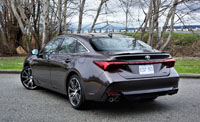
One thing we can surmise from the Avalon’s 2019 redesign is their unwillingness to quietly watch their flagship luxury sedan get eaten alive by SUV sales, even if those utilities were RAV4s and Highlanders. A brand’s flagship needs to garner a certain amount of respect, and after decades of somewhat forgettable designs the Av’s dramatic new styling should allow it to do just that.
In my opinion, the 2005–2012 fourth-generation Avalon was the most attractive ever. It was an elegant sedan that delivered surprisingly good performance than previous iterations as well. It wouldn’t be right to call it a sport sedan, but the big Av has continued to get better as the generations and refreshes passed, and now this fifth-generation, especially in base XSE form, is the most capable off the line and around curves yet.
Before filling you in on its driving dynamics, some background info: My tester’s base XSE trim line is not the least expensive version in North America. OK, let me be more specific. If you take the U.S. base price of $35,800 USD and then convert it into Canadian dollars you’ll in fact need to pay $47,128 CAD, or $4,338 more than our base price that’s actually a much better equipped model. South of the 49th the Avalon is available in XLE, XLE Hybrid, XSE, Touring, Limited and Limited Hybrid trims, which is three times as many trims as offered here in Canada. Of course, the hybrids aren’t available here, Toyota choosing to leave electrification to Lexus and its ES 300h (basically the same car as the Avalon Hybrid under the skin).

Interestingly, the pricier ES 350 and ES 300h combine for about five times as many buyers than the Avalon, but possibly even more interesting is the fact that both Lexus models are 35 times more popular in the US than in Canada, while Americans purchase the Avalon 100 times more often than Canadians, at least based on sales figures since the beginning of this year. So far, year-to-date Avalon deliveries are a paltry 212 in Canada compared to 22,453 in the US, whereas Lexus Canada’s ES sales reached 1,081 units compared to 37,896 across the line. When factoring in that the US is less than 10 times the population of Canada, it’s easy to see how much more popular these two cars are Stateside.
So either you’re American, enjoying a Canadian journalist’s point of view about your favourite car, or you’re a very, very, very rare Canadian considering a very good car that doesn’t get enough attention (you could also be an anything-car-related-junkie getting your fix on the new Av, but that’s just weird). Either way, the Avalon has exclusivity in its corner, which has an appeal of its own. Unless you’re the kind of person who likes to nod at all the folks driving Camrys as if you’ve got something special in common, you might just appreciate having Camry drivers (and everyone else) looking over at this very interesting luxury car they may have never seen. You’re unlikely to see one pulling up to the stop sign across the street, or find one parked beside you after the game, and that’s a shame as Camry XSE and XLE owners (the most obvious candidates) won’t know what they’re missing (not to mention that they can get into an Avalon for little more than they paid for their Camry).
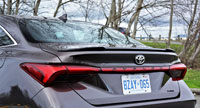
This new generation is more likely to get noticed than any previous iteration, but everything said the current trajectory for large sedan sales is down. Even the dominant Dodge Charger and Chrysler 300 twosome that achieved 4,704 combined sales over the same three quarters endured a fairly steep 14.15 and 39.31 percent slide respectively, while General Motors’ Chevy Impala and Buick LaCrosse, which pulled in 2,075 collective sales over the same time period saw their numbers fall 16.96 and 15.13 percent apiece, which without doubt made those within GM’s inner circle feel better about their cancellation. Nissan’s 710 year-over-year Maxima sales were off by 7.07 percent, which isn’t all that bad compared to every other car in this category; Toyota’s previously noted 212 Avalon deliveries resulting in a 17.19-percent downturn. And then there’s Kia that only managed to find 19 new Cadenza owners since January 1st, resulting in the category’s harshest 54.76-percent deep-dive to near oblivion. One has to wonder why Kia hasn’t discontinued the Cadenza for the Canadian market (it recently did so with the K900), and wonder more why they’re audaciously introducing an entirely new 2020 model as I write. Brave or foolish? You be the judge.
All of the cars in this class are worthy of attention, with most having served as their various brands’ flagships. This means they’re usually well stocked with all of the features offered in lesser models, and for the most part this is true for the $42,790 base Avalon XSE. Its standard features menu includes plenty, such as the previous mentioned LED headlamps and LED taillights, as well as 235/40R19 all-season tires, proximity keyless access, pushbutton start/stop, a power tilt and telescopic steering column, a leather-clad multifunction steering wheel, a 7.0-inch multi-information display, a 9.0-inch centre touchscreen with Toyota’s own Entune along with Apple CarPlay smartphone integration (but no Android Auto), SMS/text- and email-to-speech functions, advanced voice recognition, decent sounding eight-speaker audio with satellite radio, Bluetooth audio streaming, a handy wireless smartphone charger, four USB charge ports, a power glass sunroof, an eight-way power-adjustable driver’s seat, a six-way power front passenger seat, breathable Softex leatherette upholstery, heated front seats, an auto-dimming centre mirror, a remote garage door opener, two-zone automatic climate control, plus more.
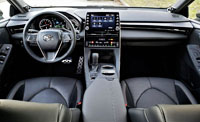
Entune Safety Connect is standard as well, including automatic collision notification, a stolen vehicle locator, an emergency assistance (SOS) button, and enhanced roadside assistance, while standard advanced driver assistance and safety systems include auto high beams, adaptive cruise control, automatic emergency braking with pedestrian detection, lane departure alert with steering assist, blindspot monitoring and rear cross-traffic warning, plus all the expected active and passive safety features including two airbags for the front occupants’ knees, etcetera.
The Avalon’s multi-information display mentioned a moment ago sits within an otherwise analogue gauge cluster, hardly anything unusual about that, but rather than just a glorified trip computer it also provides in-depth infotainment functions such as route guidance instructions exactly where needed. Atop the centre stack, the large touchscreen also shows navigation mapping in a high-resolution display, the only truly colourful application, and while Toyota’s new Entune interface is a bit drab its proprietary smartphone integration is excellent, even better than Android Auto in my opinion. You can connect to numerous functions, plus music and additional info such as traffic conditions, fuel stations, weather forecasts, stocks, etcetera via plenty of apps including Scout GPS, Yelp, Slacker, NPR One and more.
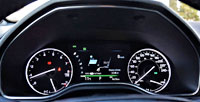
Those still needing more will want to go for the $47,790 Limited model, which includes smaller more comfort-oriented 235/45R18 all-season tires, the previously mentioned triple-beam LED headlights, more sophisticated LED tail lamps, ambient interior lighting, a 10-inch colour head-up display unit with customizable settings, a heated steering wheel, four-way power lumbar support for the driver’s seat, driver-side memory, semi-aniline leather upholstery, cooled front seats, heatable rear seats, a surround-view bird’s-eye parking camera system, navigation/route guidance, 1,200-watt 14-speaker JBL Clari-Fi surround-sound audio, Toyota Premium Audio Connected Services, a three-year subscription to Scout GPS Link, front parking sensors, autonomous rear cross-traffic braking, plus more.
The list of premium-level features above is impressive, but truly some should be standard in the base XSE I was driving. After all, the base model is getting close to $43k, so charging Canadians $5k more for a heatable steering wheel doesn’t seem right. Of course, you’ll receive a bevy of additional features with that warming wheel, but it’s hard to designate any car a “luxury” offering without this feature when so many lesser models (including Toyota’s new Corolla) offer one optionally, while some brands are even doing so as standard equipment (Kia’s $16k Forte).
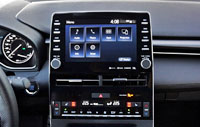
As for interior refinement, the Av provides plenty soft, pliable surfaces above the waist, including the entire dash top plus both front and rear door uppers, and the middle portion of instrument panel that features an even softer padded and stitched surface treatment, while just below is a lovely textured metallic inlay and wonderfully stylish three-dimensional metallic and black horizontal section that extends into the corner vents. The lower portion of the dash, glove box lid included, gets the segment’s usual hard plastic treatment, this spreading over to the lower door panels as well, although each door’s middle section, just under the aforementioned soft composite upper, gets a soft-touch synthetic treatment of its own, plus ultrasuede and stitched leatherette.
Outdoing the previous model’s centre stack was a tall order, and I can’t say they made the new version more appealing than the old car’s metal-finished surfacing and hollowed-out hockey stick-shaped switchgear that was totally unique and quite fabulous, but the new model’s gloss-black, glass-like design is certainly more modern and up-to-date, the upper portion standing upright like a fixed tablet while melding seamlessly into the centre infotainment touchscreen, and appearing to be held up by side buttresses that allow access to a big wireless device charging pad resting under a retractable bin lid, whereas the lower section provides digital HVAC controls including a neat row of narrow aluminized buttons, plus more. This satin-silver highlighting actually frames most of the centre stack, as well as the shift lever and cupholder surrounds plus elsewhere in the cabin, while comforting stitched and padded leatherette wraps the edge of the lower console. While shared such niceties, that should also include fabric-wrapped A-pillars, with a few premium-grade shortcomings, most should be impressed with the Avalon’s refinement.

Just in case you were wondering whether or not to move up to an Avalon from the barely smaller Camry, which incidentally shares Toyota’s TNGA-K (GA-K) platform architecture with the Avalon, as well as Lexus’ previously noted ES, the namesake brand’s flagship sedan is 100 mm (4.0 in) longer from front to back, with a 50-mm (2.0-in) longer wheelbase, plus it’s 10 mm (0.4 in) wider and only slightly lower by 10 mm (0.4 in) as well. The new Av takes up more real estate than its outgoing generation too, with its length increased by 20 mm (0.8 in) to 4,980 mm (196.0 in), its wheelbase longer by 50 mm (2.0 in) to 2,870 mm (113.0 in), its width having grown by 15 mm (0.6 inches) to 1,850 mm (72.8 in), and its overall height down by 20 mm (0.8 in) to 1,440 mm (56.5 in), the end product therefore looking longer, wider and lower for a more athletic stance.
Along with its dramatic new look, the updated Avalon provides more output under its hood, its sole engine being an upgraded 3.5-litre V6 that now puts out 10 additional horsepower and an increase of 17 lb-ft of torque resulting in a new maximum of 278 horsepower and 265 lb-ft of torque, while the XSE model I tested also includes an “Engine Sound Generator” that enhances the engine’s aural sensation by pumping a more entertaining (albeit artificial) exhaust note through the audio system when Sport mode gets selected. Incidentally, BMW does the same with its highly revered M models and Ford does likewise its Mustang and Ecoboost-powered F-150 pickup trucks (as no doubt do a number of others), with the end result being a more entertaining performance experience.

Better yet, Toyota has conjoined this modified V6 to a completely new eight-speed automatic gearbox (not a continually variable transmission, or CVT, like the Av’s supposed sportier Nissan Maxima), which means that its aging six-speed automatic is now history. Added to this are shift paddles on the steering wheel to make the extra gears and additional power a more hands-on affair.
Quietly hidden below the Av’s new avant-garde sheet metal is an elongated version of the more rigid, nimbler chassis that also enhanced the latest Camry, and as noted makes the new Lexus ES a lot more enjoyable to drive than any previous generation, while on top of this this XSE model’s front MacPherson struts and rear multi-link design gets some extra sport tuning and bigger 19-inch alloys to improve its handling further. All of the above makes it much more fun through fast-paced corners than its already capable predecessor, and while hardly a sport sedan, it would be a worthy opponent against any of its full-size, front-drive semi-luxury competitors.
In spite of all the just-noted go-fast goodies, the Av’s ride quality once again places comfort above performance, its smooth, compliant ride ideally suited to its primary luxury sedan role, and even that new multi-speed automatic engineered to shift slower than a performance fan would want in order to maintain a sense of decorum to the benefit of each and every occupant.

By all occupants I’m also referring to the driver, who is especially cared for by a particularly good seating position. This hasn’t always been the case for Toyota, which didn’t provide enough reach from their steering wheel columns more often than not, but the automaker is improving across its wide model range in this regard. Therefore, I was able push the Avalon’s primary seat amply rearward for ideal legroom thanks to a steering column that extends far enough in the same direction to bend the elbows while hands rested at the optimal 9 and 3 o’clock positions.
All said I was disappointed with driver seat’s two-way powered lumbar support, especially when factoring in that most competitive brands provide much better four-way power lumbar support in this price range, which does a much better job meeting up to the small of my back. This forced me to not use the powered lumbar at all, but fortunately the seats offered good support without any lower back adjustment, while the back seats are equally comfortable and surrounding area ultra-accommodating. Along the same theme, the Av’s trunk is sizeable at 456 litres (16.1 cu ft) and provides 60/40 split-folding extendibility for stowing long cargo, but a pass-through down the middle would’ve improved the car’s usability even more.
All in all, most premium sedan shoppers choosing to spend a bit of time with the new Avalon should like it. It’s a well built car, as all of us should expect from Toyota, offers expected be dependability, comes stuffed full of most features anyone could expect in a $40k-plus four-door, and delivers good comfort with unexpectedly strong performance.
Additionally, now that this 2019 model year is ending and the unchanged 2020 Avalon is about to arrive, Toyota should be quite motivated to rid themselves of all remaining stock, which is likely why you can to now save up to $2,500 in additional incentives (at the time of writing). You can learn about all the details right here at CarCostCanada, and while you’re at it learn about 2019 and 2020 model year pricing info, including trims, packages and individual options, plus make sure to check out the latest rebates and dealer invoice pricing that puts you in the driver’s seat when negotiating your new car.
Story and photo credits: Trevor Hofmann
